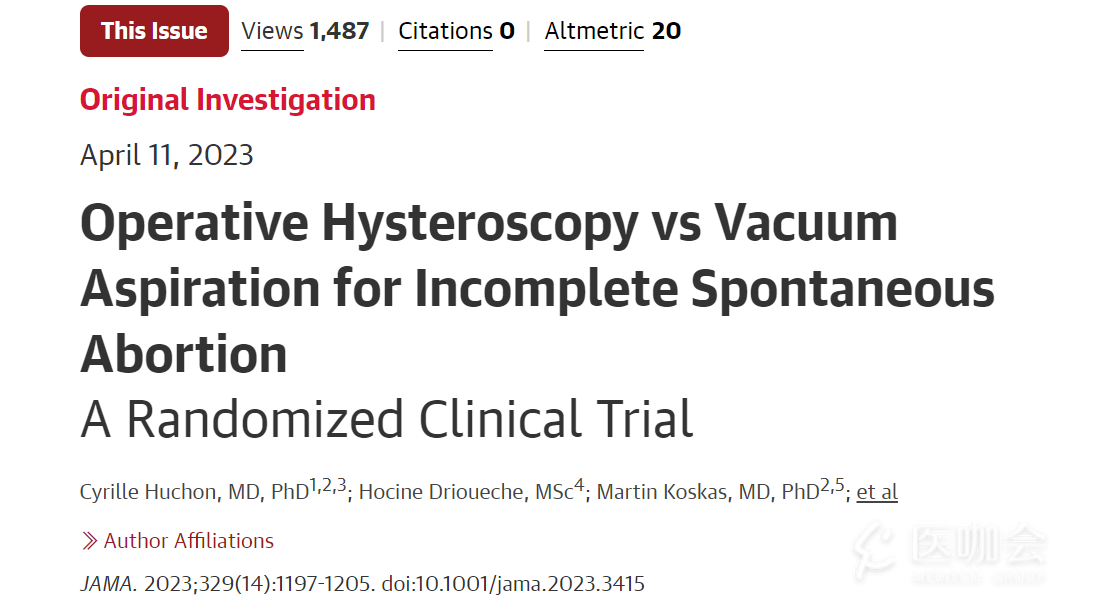JAMA:宫腔镜手术与负压吸引术治疗不全自然流产的随机对照研究
注:本文由小咖机器人翻译整理
期刊来源:JAMA
文献发表时间:2023-04-11
原文链接:https://jamanetwork.com/journals/jama/article-abstract/2803517
关键点内容如下:
问题
在不全自然流产患者中,宫腔镜在2年内获得理想妊娠方面是否优于负压吸引术?
调查结果
在这项包括574名不完全性自然流产患者的随机临床试验中,在2年的随访期间,宫腔镜检查与妊娠至少22周的后续妊娠率(62.8%)并不比真空吸引术(67.6%)更高。
意义
研究不支持将宫腔镜作为不全自然流产患者的一线手术治疗。抽象的重要性负压吸引术常用于去除不全自然流产患者残留的妊娠产物。
摘要内容如下:
重要性
真空抽吸通常用于去除不完全自然流产患者的妊娠残留产物。子宫腔可能会出现疤痕,可能会影响未来的生育能力。宫腔镜手术是一种替代手术,因其具有更好的生育能力而广受欢迎。
目标
估宫腔镜检查对不全自然流产患者再次妊娠的优越性。
研究对象
HY-PER随机、对照、单盲试验纳入了2014年11月6日至2017年5月3日期间的574名患者,随访时间为2年。这项多中心试验招募了15家法国医院的患者。年龄在18至44岁之间、计划进行不完全自然流产手术并计划随后怀孕的个体按1:1的比例随机分组。
干预措施
宫腔镜手术治疗(n = 288)或真空抽吸(n = 286)。
主要成果和措施
主要结果是在2年的随访中至少怀孕22周。
结果
意向治疗分析包括563名女性(平均[SD]年龄,32.6[5.4]岁)。完成所有抽吸程序。19名患者(7%)无法完成宫腔镜手术,其中18名患者改为真空吸引术(8名患者无法完全切除,7名患者视野不佳,2名患者出现麻醉并发症,需要缩短手术时间,1名患者出现设备故障)。1例宫腔镜检查失败,原因是宫颈扩张时出现假道。在2年的随访期间,宫腔镜组的177名患者(62.8%)和负压吸引组(对照组)的190名患者(67.6%)实现了主要结果(差异,-4.8%[95%CI,-13%至3.0%];P=.23)。时间-事件分析显示,两组间主要转归无统计学显著差异(风险比,0.87[95%CI,0.71至1.07])。宫腔镜检查的手术时间和住院时间明显较长。新的流产率、异位妊娠、3级或以上的Clavien-Dindo手术并发症(需要手术、内窥镜或放射干预或危及生命的事件或死亡)以及再次干预以去除剩余妊娠产物的发生率在两组之间没有差异。
结论和相关性
在打算再次怀孕的患者中,通过宫腔镜手术治疗不完全自然流产与真空吸引术相比,与更多的后续分娩或更好的安全性无关。此外,并非所有病例均可进行宫腔镜手术。
英文原文如下:
Key Points
Question In patients with incomplete spontaneous abortion, is hysteroscopy superior to vacuum aspiration for achieving desired pregnancy within 2 years?
Findings In this randomized clinical trial that included 574 patients with incomplete spontaneous abortion, hysteroscopy was not associated with higher subsequent rates of pregnancy of at least 22 weeks’ gestation (62.8%) than was vacuum aspiration (67.6%) during the 2-year follow-up.
Meaning This study does not support the use of hysteroscopy as the first-line surgical treatment for patients with incomplete spontaneous abortions.
Abstract
Importance Vacuum aspiration is commonly used to remove retained products of conception in patients with incomplete spontaneous abortion. Scarring of the uterine cavity may occur, potentially impairing future fertility. A procedural alternative, operative hysteroscopy, has gained popularity with a presumption of better future fertility.
Objective To assess the superiority of hysteroscopy to vacuum aspiration for subsequent pregnancy in patients with incomplete spontaneous abortion who intend to have future pregnancy.
Design, Setting, and Participants The HY-PER randomized, controlled, single-blind trial included 574 patients between November 6, 2014, and May 3, 2017, with a 2-year duration of follow-up. This multicenter trial recruited patients in 15 French hospitals. Individuals aged 18 to 44 years and planned for surgery for an incomplete spontaneous abortion with plans to subsequently conceive were randomized in a 1:1 ratio.
Interventions Surgical treatment by hysteroscopy (n = 288) or vacuum aspiration (n = 286).
Main Outcomes and Measures The primary outcome was a pregnancy of at least 22 weeks’ duration during 2-year follow-up.
Results The intention-to-treat analyses included 563 women (mean [SD] age, 32.6 [5.4] years). All aspiration procedures were completed. The hysteroscopic procedure could not be completed for 19 patients (7%), 18 of which were converted to vacuum aspiration (8 with inability to completely resect, 7 with insufficient visualization, 2 with anesthetic complications that required a shortened procedure, 1 with equipment failure). One hysteroscopy failed due to a false passage during cervical dilatation. During the 2-year follow-up, 177 patients (62.8%) in the hysteroscopy group and 190 (67.6%) in the vacuum aspiration (control) group achieved the primary outcome (difference, −4.8% [95% CI, −13% to 3.0%]; P = .23). The time-to-event analyses showed no statistically significant difference between groups for the primary outcome (hazard ratio, 0.87 [95% CI, 0.71 to 1.07]). Duration of surgery and hospitalization were significantly longer for hysteroscopy. Rates of new miscarriages, ectopic pregnancies, Clavien-Dindo surgical complications of grade 3 or above (requiring surgical, endoscopic, or radiological intervention or life-threatening event or death), and reinterventions to remove remaining products of conception did not differ between groups.
Conclusions and Relevance Surgical management by hysteroscopy of incomplete spontaneous abortions in patients intending to conceive again was not associated with more subsequent births or a better safety profile than vacuum aspiration. Moreover, operative hysteroscopy was not feasible in all cases.
Trial Registration ClinicalTrials.gov Identifier: NCT02201732








